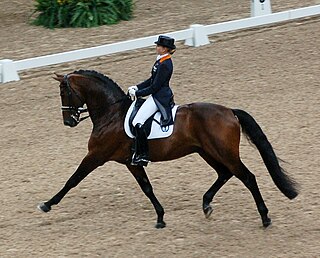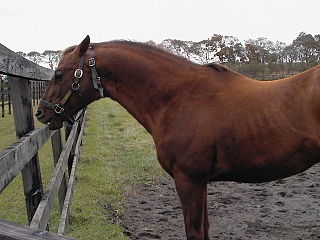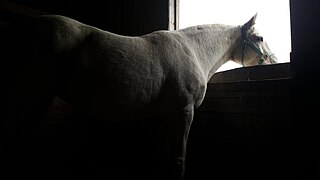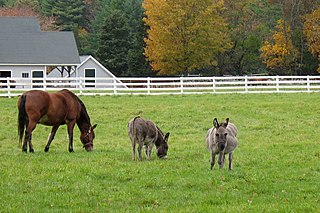Tack is equipment or accessories equipped on horses and other equines in the course of their use as domesticated animals. Saddles, stirrups, bridles, halters, reins, bits, harnesses, martingales, and breastplates are all forms of horse tack. Equipping a horse is often referred to as tacking up. A room to store such equipment, usually near or in a stable, is a tack room.

Horse teeth refers to the dentition of equine species, including horses and donkeys. Equines are both heterodontous and diphyodontous, which means that they have teeth in more than one shape, and have two successive sets of teeth, the deciduous and permanent sets.

Dressage is a form of horse riding performed in exhibition and competition, as well as an art sometimes pursued solely for the sake of mastery. As an equestrian sport defined by the International Equestrian Federation, dressage is described as "the highest expression of horse training" where "horse and rider are expected to perform from memory a series of predetermined movements."

Equestrianism, commonly known as horse riding or horseback riding, includes the disciplines of riding, driving, and vaulting. This broad description includes the use of horses for practical working purposes, transportation, recreational activities, artistic or cultural exercises, and competitive sport.

Bronc riding, either bareback bronc or saddle bronc competition, is a rodeo event that involves a rodeo participant riding a bucking horse that attempts to throw or buck off the rider. Originally based on the necessary horse breaking skills of a working cowboy, the event is now a highly stylized competition that utilizes horses that often are specially bred for strength, agility, and bucking ability. It is recognized by the Professional Rodeo Cowboys Association (PRCA) and the International Professional Rodeo Association (IPRA).

A gelding is a castrated male horse or other equine, such as a pony, donkey or a mule. Castration, as well as the elimination of hormonally driven behavior associated with a stallion, allows a male equine to be calmer and better-behaved, making the animal quieter, gentler and generally more suitable as an everyday working animal. The gerund and participle "gelding" and the infinitive "to geld" refer to the castration procedure itself.

A horse show is a judged exhibition of horses and ponies. Many different horse breeds and equestrian disciplines hold competitions worldwide, from local to the international levels. Most horse shows run from one to three days, sometimes longer for major, all-breed events or national and international championships in a given discipline or breed. Most shows consist of a series of different performances, called classes, wherein a group of horses with similar training or characteristics compete against one another for awards and, often, prize money.

Equitation is the art or practice of horse riding or horsemanship.

A crop, sometimes called a riding crop or hunting crop, is a short type of whip without a lash, used in horse riding, part of the family of tools known as horse whips.

The canter and gallop are variations on the fastest gait that can be performed by a horse or other equine. The canter is a controlled three-beat gait, while the gallop is a faster, four-beat variation of the same gait. It is a natural gait possessed by all horses, faster than most horses' trot, or ambling gaits. The gallop is the fastest gait of the horse, averaging about 40 to 48 kilometres per hour. The speed of the canter varies between 16 to 27 kilometres per hour depending on the length of the horse's stride. A variation of the canter, seen in western riding, is called a lope, and is generally quite slow, no more than 13–19 kilometres per hour (8–12 mph).

Reins are items of horse tack, used to direct a horse or other animal used for riding. They are long straps that can be made of leather, nylon, metal, or other materials, and attach to a bridle via either its bit or its noseband.

Natural horsemanship is a collective term for a variety of horse training techniques which have seen rapid growth in popularity since the 1980s. The techniques vary in their precise tenets but generally share principles of "a kinder and gentler cowboy" to develop a rapport with horses, using methods said to be derived from observation of the natural behavior of free-roaming horses and rejecting abusive training methods.

Stereotypies are repetitive, unwavering behaviours that cease to obtain a goal and lack function. One of the most common stereotypies in horses is equine oral stereotypic behaviour, otherwise known as cribbing, wind sucking or crib-biting. Cribbing or crib biting involves a horse grasping a solid object such as the stall door or fence rail with its incisor teeth, then arching its neck, and contracting the lower neck muscles to retract the larynx. This coincides with an in-rush of air into the oesophagus producing the characteristic cribbing grunt. Usually, air is not swallowed but returns to the pharynx. Wind-sucking is a related behavior whereby the horse arches its neck and sucks air into the windpipe but does so without grasping an object. Wind-sucking is thought to form part of the mechanism of cribbing, rather than being defined as an entirely separate behavior.

Weaving is a behaviour in horses that is classified as a stable vice, in which the horse repetitively sways on its forelegs, shifting its weight back and forth by moving the head and neck side to side. It may also include swaying of the rest of the body and picking up the front legs. Some horses exhibit non-stereotypical weaving, and instead engage in variations on this behavior.

Rollkur or hyperflexion of the horse's neck is an illegal practice in equestrianism defined as "flexion of the horse's neck achieved through aggressive force" and is banned by the world governing body, the International Federation for Equestrian Sports (FEI). The FEI recognises a distinction between rollkur and the riding of the horse in a deep outline not achieved by force.

Bucking is a movement performed by an animal in which it lowers its head and raises its hindquarters into the air while kicking out with the hind legs. It is most commonly seen in herbivores such as equines, cattle, deer, goats, and sheep. Most research on this behavior has been directed towards horses and cattle.

Western riding is considered a style of horse riding which has evolved from the ranching and welfare traditions which were brought to the Americans by the Spanish Conquistadors, as well as both equipment and riding style which evolved to meet the working needs of the cowboy in the American West. At the time, American cowboys had to work long hours in the saddle and often over rough terrain, sometimes having to rope a cattle using a lariat, also known as a lasso. Because of the necessity to control the horse with one hand and use a lariat with the other, western horses were trained to neck rein, that is, to change direction with light pressure of a rein against the horse's neck. Horses were also trained to exercise a certain degree of independence in using their natural instincts to follow the movements of a cow, thus a riding style developed that emphasized a deep, secure seat, and training methods encouraged a horse to be responsive on very light rein contact.

Stable vices are stereotypies of equines, especially horses. They are usually undesirable habits that often develop as a result of being confined in a stable with boredom, hunger, isolation, excess energy, or insufficient exercise. They present a management issue, not only leading to facility damage from chewing, kicking, and repetitive motion, but also leading to health consequences for the animal if not addressed. They also raise animal welfare concerns.

Bareback riding is a form of horseback riding without a saddle. It requires skill, balance, and coordination, as the rider does not have any equipment to compensate for errors of balance or skill.

The National Snaffle Bit Association (NSBA) is an equestrian organization in the United States that began by promoting and staging Western Pleasure events in 1983. Since then, focus has expanded to promoting the show horse at every level across multiple disciplines. The association is currently headquartered in Gurnee, Illinois, United States. The NSBA has a partnership with seven alliance breed organizations, including the American Quarter Horse Association (AQHA), American Paint Horse Association (APHA), American Buckskin Registry Association (ABRA), Appaloosa Horse Club (ApHC), International Buckskin Horse Association (IBHA) Palomino Horse Breeders of America (PHBA) and Pony of the Americas Club, Inc. (POAC) in order that associations can benefit from the many rules and regulations they have in common.


















